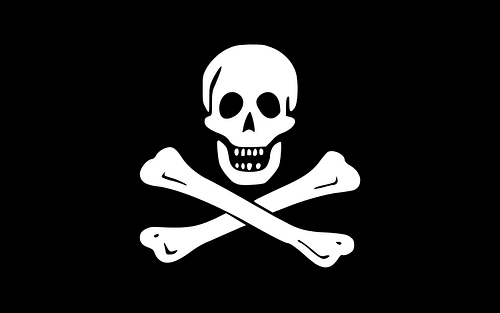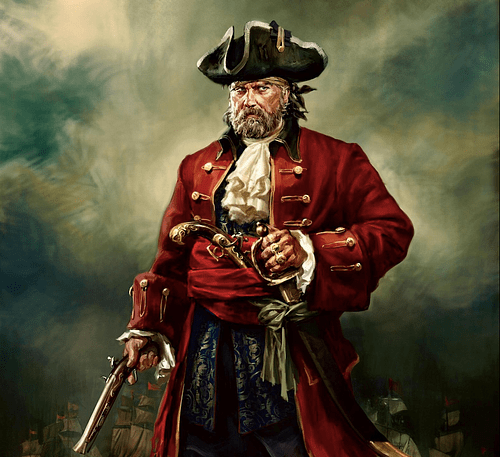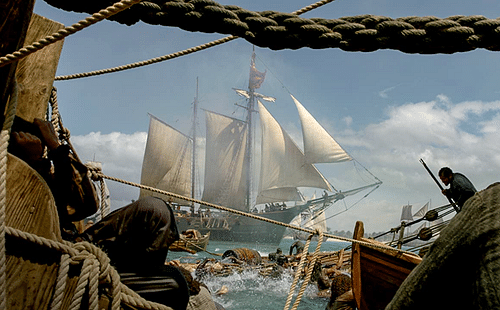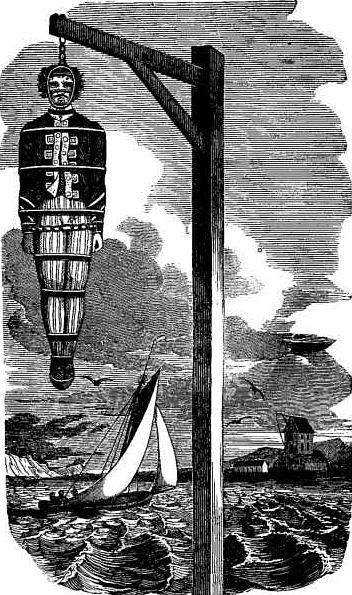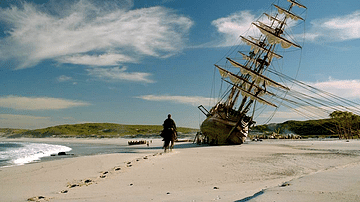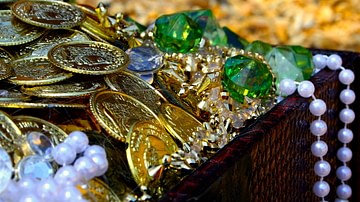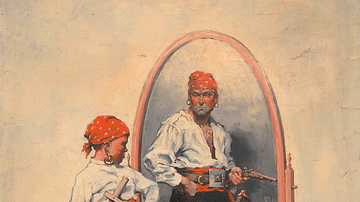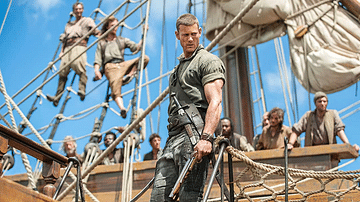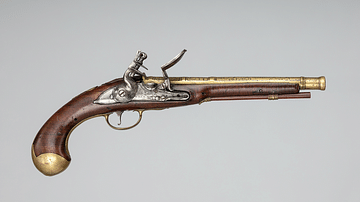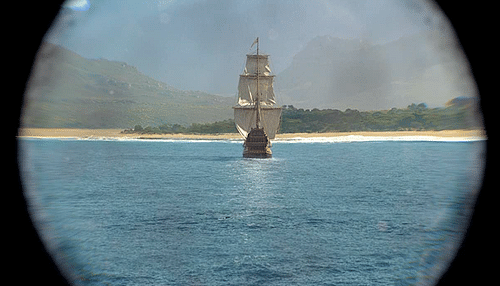
The Golden Age of Piracy (1690-1730) refers to a period when robbery on the high seas and at colonial ports reached an unprecedented level. Although not all historians agree on the precise time frame, it is generally applied to those pirates who operated in the Caribbean, the east coast of America, the eastern Atlantic, and the Indian Ocean.
Infamous names associated with the period include Captain Kidd (d. 1701), Blackbeard (d. 1718), and Bartholomew Roberts (d. 1722). These men, and some women like Anne Bonny and Mary Read, targetted merchant shipping and, much more rarely, well-armed treasure ships. The period ended when the Royal Navy, the British East India Company, and colonial governors took a much more active and aggressive stance against piracy, resulting in the capture and public hanging of hundreds of pirates from London to the Carolinas.
Defining an Era
The 'Golden Age of Piracy' is rather an odd name to attach to a period when crime was rife, but this is of secondary concern to the problem of defining what exactly this period covers. Most historians would not include the period of the buccaneers who targetted the Spanish Main and treasure ships earlier in the 17th century (c. 1650-1680). The close of that century is the most common starting point of the Golden Age for scholars, but some would restrict it to the first two or three decades, or even only the second decade of the 18th century. Here, then, in order not to omit certain points of interest pertinent to the subject of piracy, we will adopt a wider view and treat the 'Golden Age' as being approximately 1690 to 1730. It is also important to note that piracy has been conducted since antiquity and is still ongoing in many parts of the world so that an insistence on specific time frames is inherently problematic: piracy, it seems, has neither a starting nor a finishing point.
Finally, there is, too, a question of geography. While piracy in our period was rife in many other parts of the world, the term 'Golden Age' in this context is usually restricted to those pirates who operated on either side of the Atlantic Ocean, in the Indian Ocean. and off the coast of West Africa. Pirates such as those on the Barbary Coast and in East Asia are usually treated separately. The majority of the pirates in the Golden Age, therefore, are British or American, but there were significant numbers of other nationalities involved, notably Dutch and French, and pirate crews could, in fact, include anyone from just about anywhere, including former African slaves and indigenous peoples.
The question remains why piracy flourished in this particular period. Men and some women were tempted into a life of piracy by the harshness of life at sea on a merchant or naval vessel - the vast majority of pirates were experienced seamen - or because they could not find meaningful employment following the end of the wars between England and France. Following the Age of Exploration, the European colonies beyond the Mediterranean were now blossoming. These were communities growing in size and wealth and with a corresponding increase in merchant shipping to serve them. There was still, though, a lack of firm governance and military protection so far from the home nation so that many ports and ships were easy targets for pirates who cared not for the consequences of their crimes.
The Captains
While some pirate crew members have gained fame (or infamy) in their own right, the names most strongly attached to the period are those of captains. While most pirates wore the clothing that any other type of mariner wore, the captains were more wont to make a fashion statement and wear the flashy apparel the gentry of the period sported. Bartholomew Roberts (aka 'Black Bart' Roberts) was famous for wearing a scarlet silk coat, a matching damask waistcoat, and a diamond necklace. Blackbeard (aka Edward Teach) wore black ribbons in his beard, carried six pistols, and had lit fuses under his hat whenever he went into battle. Doubtless, these pirate captains were keen to create a legend about themselves that helped make sure a target vessel surrendered immediately and their own crews remained loyal.
Other captains went for a more brutal approach to gaining notoriety. Charles Vane (hanged 1721) once fired his cannons at the ship of the governor of the Bahamas, while Edward Low amassed a long list of heinous crimes such as mutilating, burning, and hanging his victims between 1721 and 1724. Captain Stede Bonnet (hanged 1718), the 'Gentleman Pirate', was unusual because he chose a life of piracy as a change of pace from running his own plantation in Barbados. Piracy, it seems, attracted all sorts.
Finally, there are those pirates who were not particularly famous in their day but who have since grabbed the public’s imagination for one reason or another. Captain John Rackham (aka 'Calico Jack', hanged 1720) was a small-time pirate now famous for his crew members of Anne Bonny and Mary Read, as well as his Jolly Roger with its crossed cutlasses. Captain Benjamin Hornigold (d. 1719) was notable for giving up piracy and becoming, instead, a pirate hunter for the governor of the Bahamas. Captain Samuel Bellamy died in relative anonymity in 1717 when his ship Whydah was sunk in a storm off Cape Cod, but his name has been revived following the underwater exploration of this wreck and its invaluable contribution to our knowledge of Golden Age pirates, their loot, and their ships.
The Pirate Ship
Although novels and films often have pirates sailing large galleon-type ships, the reality during the Golden Age was rather different. The vast majority of pirates preferred something like a sloop, which was fast, highly manoeuvrable, and capable of sailing through shallows where larger naval ships could not follow. In addition, pirates typically went after easy targets such as merchant vessels armed with no more than a handful of cannons. However, there were some notable exceptions as some pirates preferred a larger ship capable of matching a lower-rated naval vessel in firepower. Prestige was also a factor, and it is significant that the more notorious and successful pirates did possess the largest ships.
Captain Kidd sailed the purpose-built Adventure Galley. This was a 287-ton three-masted ship, which could pursue a target in all conditions thanks to its mix of square-rigged sails, lateen sail (triangular), and banks of oars (46 in total). The Adventure Galley was crewed by over 150 men and was well-armed with 34 cannons. Edward England captured a fine ship off Madagascar in 1720, which he renamed the Fancy. This vessel also boasted 34 cannons and had a crew of around 180 men.
Perhaps the most famous of pirate ships is Blackbeard’s Queen Anne’s Revenge, another captured vessel, this time a French slaver. The Queen Anne’s Revenge had a crew of at least 300 men, necessary to man the 40 cannons on board. The most powerful pirate ship of all in this period was Bartholomew Roberts’ Royal Fortune. The former French warship bristled with at least 42 cannons, and Roberts used it well, adapting it for speed and becoming the most successful of all Golden Age pirates in terms of ships captured, well over 400.
Methods of Attack
Pirates typically targeted lone merchant vessels, usually when they were negotiating a narrow straight or were near shallows and islands so that a pirate ship could seemingly arrive out of nowhere. A pirate vessel might also get close to a target by flying a certain friendly national flag. Approaching from the stern was always a good idea since ships of the period had far fewer cannons there.
The first weapon pirates used was terror, and this took the form of the Jolly Roger flag. When this flag was hoisted - usually black with a human skull and crossbones, although many variations existed - a merchant vessel was being warned that pirates were approaching, and the sensible thing to do was not to put up any resistance. A red flag might also be hoisted, which signalled that no quarter would be given if an attack began. As most pirate victims were poorly-armed, the pirates usually boarded their target with ease.
For those ships that resisted, the pirates had an array of weaponry to choose from. Pirate ships, as we have seen, carried many cannons of various sizes, and the pirates themselves carried grenades, muskets, pistols, cutlasses, axes, and clubs. Firing cannons was not so common since pirates did not want to damage the target ship or its cargo, both of which might be useful to them. For this reason, when cannons were fired, it was typically as warning shots or to fire chain shot (two bars or balls connected by a short chain) which was designed to destroy rigging and masts and so temporarily disable the target vessel. Some pirate captains were tempted into attacking well-armed treasure ships, especially if they commanded a fleet of pirate ships and so enjoyed a great numerical advantage in cannons and men. As naval vessels almost always outgunned a pirate ship, these were avoided by pirates.
Pirate Booty
Pirates were first and foremost after portable loot, preferably gold, silver, and gems. Coins were the most easily disposed of and so a treasure chest of Spanish silver pesos (aka pieces of eight) or gold doubloons was most desirable. The next best thing was a valuable cargo. Items that could be easily sold included rolls of silk, spices, indigo, tobacco, rum, furs, hides, sugar, and other foodstuffs. The crew and any passengers were stripped of any valuables and fancy clothing. Weapons, navigational instruments, and medicines were always useful. Even humdrum nautical items like ropes, sails, and anchors were taken to replenish the pirates’ own equipment. Finally, the attacked ship could itself become the prize. Pirates were loath to spend time and effort repairing their own ship and so swapping for a more seaworthy vessel was quite common, as was upgrading to a bigger and better ship capable of carrying more cannons.
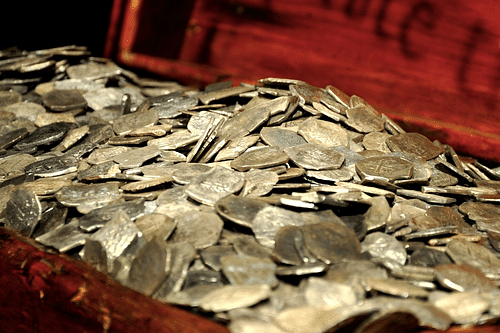
While most captures brought only dry goods or liquor and perhaps a few coins, there were some truly staggering captures in the Golden Age. The English pirate Henry Every (b. 1653) captured the Ganij-i-Sawai in 1695, a merchant ship of the Mughal emperor, which was carrying cargo worth over $95 million today. The share for each crew member was more than a lifetime’s wages. Wisely, Captain Every sailed over the horizon with his loot and was never seen or heard of again.
In 1721, the biggest ever single prize was captured by John Taylor and Olivier La Bouche. Together, the two pirate ships boarded the Portuguese treasure ship Nostra Senhora de Cabo at Réunion Island. There was £500,000 in diamonds, gold, and other valuables, and a general cargo worth £375,000 (a total of over $250 million today).
Booty was supervised by the quartermaster until such time as it could be shared out or sold and the proceeds divided. Crew members typically got one share each, the quartermaster and captain received two shares each, and the various 'officers' or more experienced seamen and skilled workers like the carpenter and gunner got something in between one and two shares. Crew members were also compensated for any injuries they had sustained during an attack. Few pirates ever kept hold of their ill-gotten gains long enough to think about hiding it away somewhere. Tales of buried treasure may appear frequently in pirate fiction, but there are few historical records of such behaviour. Captain Kidd did bury treasure, perhaps on Long Island, but treasure-seekers have remained frustrated at their lack of success in finding any of it.
Pirate Havens
Once loaded up with booty, pirates retreated to their haven. The main havens were Port Royal (Jamaica), Tortuga (Hispaniola), New Providence (Bahamas), and Madagascar in the Indian Ocean. Havens were chosen for their secluded and safe harbours and easy access to freshwater, fruit, meat, and timber in the island’s interior. Being close to the main shipping routes but not too close to the colonial authorities were distinct advantages, too.

Traders to buy looted cargo were essential, and they were attracted to havens because they could buy goods cheaply and then smuggle them into legitimate ports at much higher prices. The pirates lost out on the deal, but they got what they wanted: ready cash and plenty of booze. Some pirate captains were more ambitious and tried to deal directly with colonial ports where officials could be bribed and goods sold at better prices. Some of these officials, the most notorious being Charles Eden, governor of North Carolina, and Colonel Benjamin Fletcher in New York, even gave out pardons to pirates.
Many pirate havens soon grew into large towns with inns, brothels, merchant stalls, and everything else mariners needed and desired when resting their sea legs. New Providence Harbour (Nassau) hosted some 600 pirates at its peak c. 1700, while at the same time, Madagascar had 1,500 pirates using the island as a base. Port Royal was a favourite of the buccaneers, but Golden Age pirates continued to make good use of its 100 taverns and other dubious facilities which gave rise to its nickname as the 'Sodom of the New World'. Port Royal was used in this way until its destruction during an earthquake in 1692.
Justice & the Decline of Piracy
The British government, pressured by legitimate merchants, colonists, and rulers such as the Moghul emperor was eventually obliged to act against piracy. The government was also greatly concerned that piracy was so rife it was driving out honest settlers from its colonies and leaving them so unpopulated they were becoming a great temptation for foreign powers to take over. From 1701, colonies were permitted to try and hang pirates themselves rather than ship them to England. In the 1710s, colonial governors like Woodes Rogers (1679-1732) in the Bahamas were sent out from London specifically to replace the often corrupt government apparatus in the colonies and wipe out piracy in their jurisdiction. These new governors had both a carrot and stick to achieve their brief. The stick was naval warships and the hangman’s noose, while the carrot was a royal pardon from King George I of Great Britain (r. 1714-1727) and the promise of land and work in the colonies. Many pirates did accept a pardon, and those who did not were eventually hunted down. An additional strategy which worked well was to offer cash rewards for those who informed on and captured pirates; many of these informers were former pirates themselves.
New Providence was shut down as a pirate haven in 1718. The Royal Navy became an ever-more powerful presence in the western Atlantic, and when the colonial governors heard of illegal trade going on in any new havens, they moved in swiftly with their warships. There was also a change of tactic with the navy, like the pirates themselves, opting for fast sloops instead of heavy gunships to pursue these criminals of the high seas. At the same time in the Indian Ocean, the East India Company began to use convoys and more aggressively protect its assets at sea. With their havens under attack and with far fewer possibilities to sell on stolen goods, a life of piracy became a very difficult one. It was also now much more dangerous as capture became more likely and the punishments harsher.
The old days of letting off most pirate crews with a flogging as a warning and hanging only the captain were over. Now, entire crews were being brought to justice in show trials that ended in mass executions. In 1722 at Cape Coast Castle, Guinea in West Africa, 52 of Bartholomew Roberts’ crew were hanged in one day. At places like Execution Dock in Wapping, London, or Deadman’s Cay near Port Royal, the sight of hanged pirates swaying in the sea breeze became a familiar one to locals and passing ships. The most notorious pirates had their corpses hung in an iron cage, left to rot in the open air for one or two years. Even those who escaped the death sentence often only had their fate delayed as they were either given lengthy sentences in disease-ridden prisons or transported to penal colonies for a short sharp life of hard labour.
Piracy was never entirely stamped out, it is, after all, one of those crimes that seems to have always bedevilled humanity. However, as colonies came to establish themselves with more robust institutions of government and justice, so more people had a cause to see the end of piracy. Even the pirates themselves, those who had escaped the hangman’s noose, often settled down to a more respectable living on plantations or operated as honest merchants, the very targets they had once terrorized.
